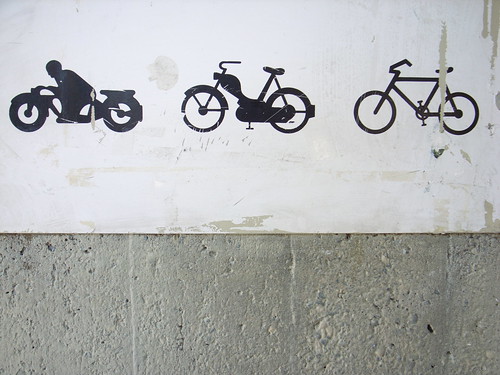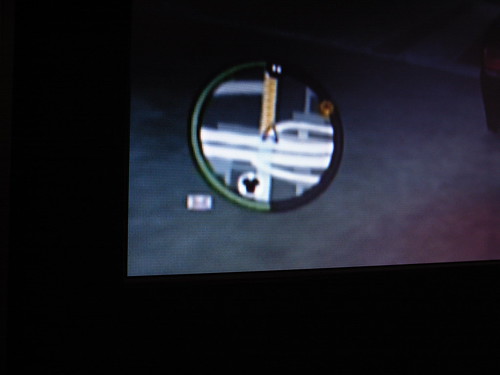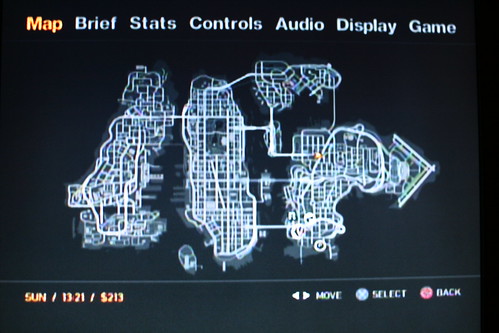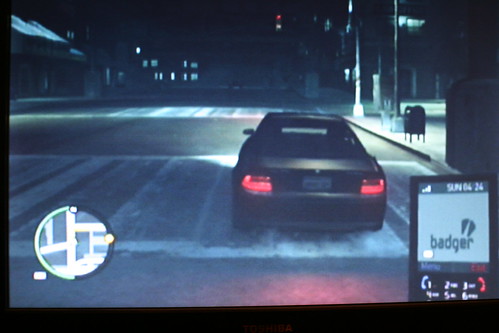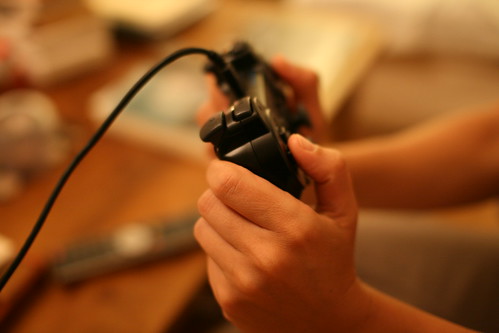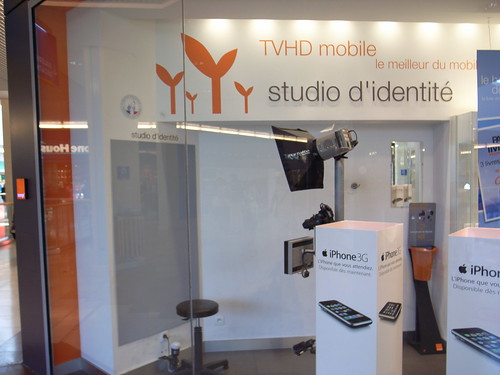 Defensible space produced with lower-end means in Cuzco, Peru: shards of glass and cactus as a deterrent to jump over that wall. The next occurence is less complex but also shows the use of glass:
Defensible space produced with lower-end means in Cuzco, Peru: shards of glass and cactus as a deterrent to jump over that wall. The next occurence is less complex but also shows the use of glass:
Ethnographic outputs for design
Working lately on how a course and a seminar concerning how ethnography can produce relevant and adequate material for design, I read "The ‘adequate’ design of ethnographic outputs for practice: some explorations of the characteristics of design resources" (by Tim Diggins & Peter Tolmie) with great interest. Published in Personal and Ubiquitous Computing in 2003, it used to sit on my laptop for ages and I finally got time to peruse it properly. The paper deals with the difficulties of making good use of ethnographic output in multidisciplinary user-centred design team and discusses some pertinent observations about the kind of characteristics the result may take for a successful collaboration between designers and UX researchers. Although they acknowledge there is no overall consensus concerning this question, the authors acknowledge the importance of employing diagrams as representational devices. Which reminds me of this other paper by Hughes et al. entitled "Moving Out from the Control Room: Ethnography in System Design" which claimed that "The output of ethnographic analyses are typically discursive and lengthy, looking nothing like the blueprint diagrams which are de rigeur in systems engineering".
After an analysis of few ethnographically-inspired diagrams, the authors nail out the characteristics and problems that can be encountered. They propose their own representational vehicle along with an organizational solution:
"so that a particular formulation of ethnographic material is locally (indexically) relevant, it must have provide for mutual appopriateness among the interested parties (i.e. the design team). And mutual appropriateness is something that is worked up in situ between the ethnographer and designer, rather than something open to generic pre- formulation. The grounded innovation map was, for us, a mutually appropriate means of representing the ethnographic work for design, and it was designed and redesigned by us according to current need. (...) It’s worth noting that the actual work of arriving at a mutually appropriate (and mutually acceptable) form, is arguably the most important output of the formulation itself – it is in this collaborative design and negotiation that some of the most important transfer of understandings can take place. (...) The interest is not in exporting detail, but rather in supporting the provision of information that is relevant and meaningful for the purposes in hand. At the same time it is important not to consider these devices to be offering generalisations to cover all ends (...) it is a mistake to presume that generic claims will be relevant and meaningful to just any particular design enterprise (...) This also forcefully underscores the importance of colocating designers and ethnographers on the same design teams."

They then describe the different characteristics of such representation (that they the "grounded innovation map" as represented above):
- Form: economy (appropriate for its presentational use, whether screen-based or on paper), appropriate format (to a given subset designers)
- Use: ordering & logic of practice (how the representation is delivered), indexicality (should have internal features that can be pointed out and explicated in a variety of ways, both in terms of occasioning particular ethnographic accounts and/or recollections for debriefing), mnemonicity (a resource for a member of the design team, for calling to mind instances from the fieldwork)
- Embededness: iconicity (physical resource and support for talking about the ethnography in multiple settings), sequentiality and organisational accountability (serve to show that certain kinds of work and collaboration have been done), integration (provide common resources for those right across a multidisciplinary/multi-organisational project)
- Warnings: reductivity (it may be seen to replace the diversity and irreducibility of the fieldwork observations.), constraint (the local groupings and categorisations within the representation may come to have too great a significance and become constraints on further interrogation of the fieldwork and thinking about the design space.)
- Strategies for coping with warnings: change (engendering a lack of attachment to a particular phase of the representation by continual editing and change), instantiation (the deliberate bringing-up of ‘difficult’ instances that cut across the local categorisation), open-endedness/incompleteness (the deliberate avoidance of once-and-for-all formulations that are presumed to ‘explain’ the domain for all purposes), self-insufficiency (Making sure that the representation is not self-sufficient, but instead requires either a locally gathered competence with it or an accompanying explanation).
Why do I blog this? always struck by how this topic is rarely discussed on depth in various UX/IxD/HCI documentation, I am starting to collect material about it to go beyond the current practices. I do admit that some of the ethnographically-inspired research I've dealt with lately were not that imaginative in terms of output and I want to change this. Perhaps it can be caused by the client (who want above all a report with text, text and text) but I am sure one can iron out more adequate material. I generally use lots of pictures in my report too and some higher-level diagrams but it's always good to have some pointers and guidelines about how to craft them more nicely.
On a side note, I am wondering about the importance of providing both primary (pictures, narratives, video excerpts) and secondary data (higher-level representations such as diagrams). Combining both in a topic-map way could be a solution, as described in the paper.
Finally, I found interesting here the notion of organizational solution, with the UX researcher(s) and designer(s) working together to produce this output. Too often both are working in different units and not producing something together.
Diggins, Tim, and Peter Tolmie (2003) "The 'adequate' design of ethnographic outputs for practice: some explorations of the characteristics of design resources" in Personal and Ubiquitous Computing, Volume 7 (3-4) July.
Yahoo-like logo
Street typewriting in Peru: the public scribe
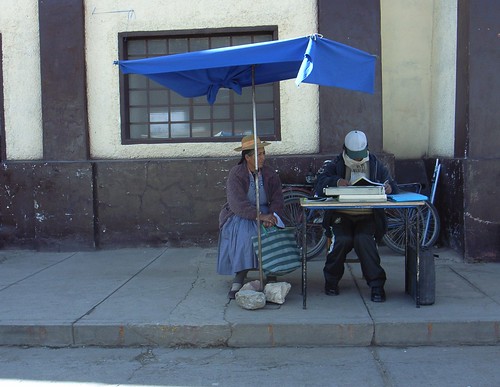 Another category of service you find on the street in Peru (as well as other countries) is the public scribe (in Ayaviri above and Arequipa below). Generally sat somewhere at a desk or on stairs, aided by a typewriter, he/she serve the needy illiterate to writer different things, especially administrative pieces of work. A sort of surrogate to the written world, the public scribe seems to be an important component in the large bureaucratic and technical systems in Peru composed of photographers, photocopy shops and internet cafés.
Another category of service you find on the street in Peru (as well as other countries) is the public scribe (in Ayaviri above and Arequipa below). Generally sat somewhere at a desk or on stairs, aided by a typewriter, he/she serve the needy illiterate to writer different things, especially administrative pieces of work. A sort of surrogate to the written world, the public scribe seems to be an important component in the large bureaucratic and technical systems in Peru composed of photographers, photocopy shops and internet cafés.
Hands on
The NYT had a good piece about how digital designers rediscover hands-on activities. With examples from Adobe and Mike Kuniavsky's Sketching in Hardware gatherings, the article describes the renewed interest in manual tinkering "or innovating with the aid of human hands". Some of the reasons for that described in the article:
" “A lot of people get lost in the world of computer simulation,” says Bill Burnett, executive director of the product design program at Stanford. “You can’t simulate everything.” (...) The hands-on part is for me a critical aspect of understanding how to design,” said Michael Kuniavsky (...) Such experiences hone instinct and intuition as opposed to logic and cognition, advocates say, and bring the designer closer to art than science. (...) At Stanford, the rediscovery of human hands arose partly from the frustration of engineering, architecture and design professors who realized that their best students had never taken apart a bicycle or built a model airplane. (...) “Students are desperate for hands-on experience,” says Neil Gershenfeld (...) “People spend so much time in digital worlds that it creates an appetite for the physical world,” says Dale Dougherty, an executive at O’Reilly Media"
Why do I blog this? Beyond the obvious interest in this interest in bricolage, these remarks echo a lot with my personal experience with students. Few years ago, in a course about interactive table, we asked master students to design tables per se: drawing shapes, cutting huge pieces of woods, adding a beamer, etc. and they really loved it saying that it was the first time they had to design something physically in their engineering school.
Ambivalence towards future and design
"The best way to invent the future is to predict it"John Perry Barlow - The Future of Prediction (2004), In Marita Sturken, Douglas Thomas, Sandra Ball-Rokeach (Eds). Technological Visions, p. 177.
"The best way to predict the future is to invent it" Alan Kay - Early meeting in 1971 of PARC, Palo Alto Research Center, folks and the Xerox planners
Why do I blog this? ruminating on the ambivalence of common quotes in the technology world. Quite enjoy how the two above intersect in a weird way when pit next to one another. While the first one is more about self-fulfilling prophecy the second is about our capacity (as human) to create our own future.
GPS-related accidents
Not the best technical source but some intriguing GPS-related accidents are described in the Mirror:
"SCOTLAND: In May, Scottish ambulance drivers were told to ignore their new £5m satnav system and use maps instead after drivers complained they were not being directed by the quickest route to 999 calls.DEVON: The same month, a skip lorry driver's satnav sparked rush-hour traffic chaos in Newton Abbot, Devon, after taking a wrong turn and getting stuck under a bridge.
WALES: Paula Ceely, 20, vowed never to listen to her satnav again after she was directed into the path of a speeding train at the Ffynnongain level crossing in Wales. The train slammed into her car, leaving the student within inches of her life. No one was hurt.
CORNWALL: A satnav was also blamed when a lorry driver took a wrong turn into a cul-de-sac in Wadebridge, Cornwall, in January last year. The driver left seven cars badly damaged when he performed a U-turn to correct himself."
Why do I blog this? although I am skeptical about the figures quoted in that article, the qualitative appraisal of situations caused or related to GPS usage are interesting.
Llamadas: mobile+human pay phone
 One of the most interesting service you find on the street in Peru (and I am sure you can also get it in other countries) is the "llamadas". It's generally women or teenagers with a bundle of mobile phones and a stop-watch who act as pay phones. They wear colorful clothes with mobile carriers brands and the "llamadas" logo (that they also shout when you pass by).
One of the most interesting service you find on the street in Peru (and I am sure you can also get it in other countries) is the "llamadas". It's generally women or teenagers with a bundle of mobile phones and a stop-watch who act as pay phones. They wear colorful clothes with mobile carriers brands and the "llamadas" logo (that they also shout when you pass by).
In the example below taken in the village Ayaviri, you can see a local coming with the phone numbers written on her notepad to ask the llamadas to call it. They are ubiquitous in city centers, often found near the Plaza de Armas.
A sort of mobile human phone booth in a sense, a proxy for your call.
Bricks from the ground
 Turning raw material into "concrete" and actionable items for building constructions. Or, how to create bricks from the ground and then sell them to others. Can only be done in the dry season using a wooden mold. Seen in Canyon de Colca, Peru.
Turning raw material into "concrete" and actionable items for building constructions. Or, how to create bricks from the ground and then sell them to others. Can only be done in the dry season using a wooden mold. Seen in Canyon de Colca, Peru.
What is interesting here is the proximity between the raw material and the end product, a very short production cycle and the use of basic Sun/Wind capabilities to dry the bricks.
See also Jan Chipchase's post about that topic.
Phone affordance on manhole cover
A remnant from a past affordance found in a city environment. Seen in Lima, Peru. When manhole cover allowing the access to phone lines take the shape of rotary telephones (for post-80 reader people had to "rotary dial" a phone number).

Taleb's "fooled by randomness"
Reading "Fooled by Randomness: The Hidden Role of Chance in Life and in the Markets" (Nassim Nicholas Taleb) in the midst of Peru was a pleasant thing. Basically, Taleb, a "post-trader" gives an interesting account of how human judgement is fallible, especially because we tend to fall in the apophenia trap. I particularly cherished the part about the author's habits concerning information gathering/data farming:
"My aim, as a pure amateur fleeing the boredom of business life, was merely to develop intuitions for these events - the sort of intuitions that amateurs build away from the overly detailed sophistication of the professional researcher. (...) When I see an investor monitoring his portfolio with live prices on his cellular telephone or his handheld, I smile and smile. (...) I reckon that I am not immune to such an emotional defect. But I deal with it by having no access to information, except in rare circumstances. Again, I prefer to read poetry. If an event is important enough, it will find its way to my ear. (...) This explains why I prefer not to read the newspaper (outside of the obituary), why I never chitchat about markets, and, when in a trading room, I frequent the mathematicians and the secretaries, not the traders. It explains why it is better to read the New yorker on Mondays than the Wall Street Journal every morning (from the standpoint of frequency, aside from the massive gap in intellectual class between the two publications). (...) Some so-called wise and rational persons often blame me for "ignoring" possible valuable information in the daily newspaper and refusing to discount the details of the noise as "short-term events." Some of my employers have blamed me for living on a different planet. My problem is that I am not rational and I am extremely prone to drown in randomness and to incur emotional torture. I am aware of my need to ruminate on park benches and in cafés away from information, but I can only do so if I am somehow deprived of it."
I quite enjoyed the last part since it's exactly the reason why I walk around in cities or take so much trains: to have time to ruminate from different "information-filled" places: the internet, my apartment and newsstands+book-shops.
Moreover, his list of "bias" in foresight is also insightful. Although he applies it to trading, it definitely outreach this domain. Some of the bias:
- "When you look at the past, the past will always be deterministic, since only one single information took place. Our mind will interpret most events not with the preceding ones in mind, but the following ones. (...) The "hindsight" bias, the "I knew it along" effect. (...) A mistake is not something to be determined after the fact, but in the light of the information until that point.
- Survivorship bias: we are trained to take advantage of the information that is lying in front of our eyes, ignoring the information we don't see (...) we tend to mistake one realization among all possible random histories as the most representation among all possible random histories as the most representative ones, forgetting that there may be others. In a nutshell, the survivorship bias implies that the highest performing realization will be the most visible. Why? Because the loser do not show up.
- Ergodicity: time will eliminate the annoying effect of randomness (...) under certain conditions, very long sample path would end up resembling each others.
- Prospect theory: looking at differences, not absolutes, and resetting to a specific reference point.
- Affect heuristic, risk-as-feeling theory: people react to concrete and visible risks, not abstract ones.
- Belief in the law of small numbers: inductive fallacies; jumping to general conclusions to quickly
- Overconfidence: risk-taking out of an underestimation of the odds
- Mistaking mean and median"
Also of great interest to me is the discussion about the importance of exceptions and outliers, which is also the topic of his second book:
"People in most fields outside of it do not have problems eliminating extreme values from their sample, when the difference in payoff between different outcomes is not significant, which is generally the case in education and medicine. A professor who computes the average of his students' grades removes the highest and lowest observations, which he would call outliers and takes the average of the remaining ones, without his being an unsound practice. A casual weather forecaster does the same with extreme temperature - an unusual occurrence might be deemed to skew over the results. (...) So people in finance borrow the technique an ignore the infrequent events, not noticing that the effect of a rare event can bankrupt a company. (...) As a skeptic, I reject a sole time series of the past as an indication of future performance; I need a lot more than data. My major reason is the rare events but I have plenty of others. (...) The problem is that we read too much into shallow recent history, with statements like "this has never happened before" but not from history in general (things that never happened before in one area tend to eventually happen)."
The reason why I mention this is that I am especially interested in the role of exceptions, outliers in design as I already discussed here. Why do I blog this? Quite liked the book, both for the content and the way the author describes his thoughts with this grecosyrian/mediterranean who went to anglo/french board school and university, which makes it a tad poetic in terms of references and examples. Certainnly a good reference about foresight and some elements to draw concerning thinking habits.
Back here
Where magic is also used as a teaser to make you employ technological artifacts (such as Internet/TV cable in this case).
on vacation
GTA and ubiquitous computing
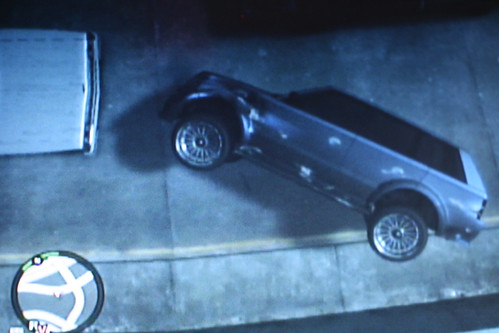 Toying around Grand Theft Auto IV lately, I've been interested in how today's ubiquitous computing can help to create original game play features in a console game. There are three interesting elements about this topics: the in-game GPS, the use of the cell-phone in the game and the role of tangible interactions.
Toying around Grand Theft Auto IV lately, I've been interested in how today's ubiquitous computing can help to create original game play features in a console game. There are three interesting elements about this topics: the in-game GPS, the use of the cell-phone in the game and the role of tangible interactions.
The GPS in the game is an important feature as it guides you to specific place where you have to do specific things. But you often end up relying more on it to drive than looking the street view since the action takes place in a very dark areas (especially if like me you have a tendency to bump-and-destroy lots of street lamps). So far, I have only used cars with graphical indication but I've heard there are some luxury cars which talks the player through the streets. Unlike lots of real situation the markers and waypoints that appear on the tiny maps are really accurate and often well updated. Given the complexity of Liberty City, driving is much simpler than in past GTA games.
So, to some extent, geolocation in GTA is used as an enabling feature to help people getting around and making sense of that complex environment. You can avoid to use it but then the gameplay becomes weird since the world is very big and you might miss the place where the action is. That said, I haven't seen any glitch or GPS trouble yet; I would be intrigued if the game designers used GPS miscalculation as a challenge.
In this case, the cell-phone is both a trigger for actions (like the GPS) but also an intriguing social feature that is less utilitarian. See for example what some game critics think about it:
"You'll keep in touch with your dates, friends, and some of your enemies using another of GTAIV's great new features: a cell phone," he says. "There's no unwieldy conversation system to deal with; you simply choose which friend you want to call, what you want to talk about (it could be work, a fun activity, or asking for a favor) and then, assuming that he or she answers the phone, the conversation plays out."
This results in appreciable gameplay benefits. "The rewards that you get when another character likes you enough vary depending on who it is," Calvert explains. "Without wishing to give away specifics, befriending a lawyer can prove useful if you're having trouble with the cops, for example, and having a nurse on your friends list can literally be a lifesaver." (...) "The mobile phone is central to this, allowing you to make phone calls and text-message people one-handed while you walk or drive; networking, socialising, organising, and listening to that ringtone you downloaded for America's Next Top Hooker," Bramwell explains. "When you fail a mission, you can answer a text to teleport yourself back to wherever you spawn after the cut-scene briefing finishes.""
Finally, the pace of cell-phone use is sometimes so important that it nicely reflects the current discussion about how mobile devices help hyper-coordination and attest of the intensification of relationships between people (mmh game characters) close to what Antony Townsend describes in his paper Life in the Real-time City: Mobile Telephones and Urban Metabolism . In the real-world hypercoordination is now a given, in GTA IV it's clearly a game feature.
While the GPS and cell phones are in-game elements, the last ubicomp feature in GTA IV is certainly the interaction mode using the discontinued sixaxis: the ability to sense both rotational orientation and translational acceleration along all three dimensional axes, providing six degrees of freedom. I personally found it problematic and not accurate, way too sensitive by my standards. And it seems that I am not alone having that feeling, using a tangible interface to control an helicopter may sound cool at first glance but it's awfully bad in GTA IV.
Attach a knob to your display
 (via), an intriguing assemblage between a touch/gestural interface and a classic laptop screen: Sense Surface allows to use real physical controls added on the display on the top row:
(via), an intriguing assemblage between a touch/gestural interface and a classic laptop screen: Sense Surface allows to use real physical controls added on the display on the top row:

Here's their description:
"SenseSurface can be used with most laptops with a USB input. The sensing knobs have a custom designed movement sensor to determine position within a range of 180 degrees with a 10 bit digital output, linearity typically 1%. The magnetic knobs can be removed and repositioned immediately by picking them up and moving to a different part of screen. A unique sensing x/y matrix is attached to the rear of the laptop screen to detect the control's position. The distance of the sensor from the screen can also be detected. The rotary controls are low friction and there are no screen finger prints as with normal touch surfaces. Linear sliders and switches can also be used on the lcd surface. For audio use, a logarithmic response can be programmed. The system is multitouch and scaleable , the number of controls on the screen is limited by the size of the screen. The screen can be at any angle."
Why do I blog this? I find intriguing the notion of gestural interface through knobs as a an add-on to a normal input/output device.
"Future overwhelmed"
Starting with a discussion of Disney's Tomorrowland, Joel Garreau has a good piece in the Washington Post concerning how americans feel very little connection to the future anymore. Unlike the past, especially in the 50s (till the 80s), he describes how people are "future overwhelmed" using the term employed by Danny Hillis. According to Garreau, Disney's Tomorrowland seems to be a reassuring future aspiration as its "focus is on what doesn't change": ranging from intact nuclear family to "vigorous grandparents" and "the sound of crickets". Garreau examines why this is not the future we have in the research pipeline and what the disconnection between this representation of the future and current research says about us. Some excerpts:
"The '60s and '70s were not good to the original Disney vision of the future. The Vietnam War, the assassinations, the revolt against anything square, the idea that big corporate computers only served to mangle individuality and imagination, the civil rights movement, the environmental movement, the women's movement -- all challenged the notion that every day, in every way, things were getting better and better.
Even more profoundly, the 2,000-year-old idea of the inevitability of "progress" was taking holes beneath the waterline. As Robert Nisbet notes in "History of the Idea of Progress," across every ideology, people stopped believing one or more of the major premises that were its underpinnings -- that reason alone, and the scientific method, was inherently worthy of faith; that economic and technological flowering was unquestionably worthwhile; that Western civilization was noble and even superior to its alternatives. The theme of the Jimmy Carter years was "malaise." (...) The damage to the idea of a benevolent future, however, had been done. The punk rock Sex Pistols, in their anthem "God Save the Queen," sang: "No future for you no future for me/No future no future for you." (...) Sometimes it takes guts, trying to dazzle people with the current future. (...) "It's much harder to astound people today, " says Marty Sklar, the former principal creative executive of Walt Disney Imagineering, who in 2001 was named a "Disney Legend" for his work going all the way back to Walt's era in the '50s. "They see the speed of change all around them.""
And the best part is certainly these quotes from Danny Hillis:
""Americans feel very little connection to the future anymore," says Danny Hillis. (...) "It was very surprising to me, getting to the future, that nobody was all that interested. Things just started to happen so fast, we were overwhelmed. (...) "We are future overwhelmed. I don't think people try to imagine the year 2050 the way we imagined 2001 in 1960. Because they can't imagine it. Because technology is happening so fast, we can't extrapolate. And if they do, it's not a very positive thing to imagine. It's about a lot of the unwanted side effects catching up to us -- like global ecological disaster. The future views are kind of negative. "What I think it says is that we are nostalgic for a time when we believed in the future. People miss the future. There's a yearning for it. Disney does know what people want. People want to feel some connectedness to the future. The way Disney delivers that is to reach back in time a little bit to the past when they did feel connected. "It's a bit of a cop-out. There was a time when the future was streamlined jet cars. Rather than create a new sense of the future, they say, 'Ah, remember when we believed that the future was streamlined jet cars?' It's a feeling of connection to the future, rather than connection to the future."
Why do I blog this? still gathering stuff about failed and deflated futures for my project.
Design and robotics
Focusing lately on networked objects and robots for a project, I re-visited the interview of Carl Di Salvo made by Dan Saffer in his book Designing for interaction.
 (Nintendo Chiritorie, a remote controlled vacuum cleaner designed by Nintendo back in 1979)
(Nintendo Chiritorie, a remote controlled vacuum cleaner designed by Nintendo back in 1979)
The point which interested me here is the role design plays in robotics:
"What type of design work is being done with robots now?
Perhaps the most obvious is the work in industrial design in creating the visual form of the robot. The industrial design of a robot is an example of styling visual form with significant impact on interaction. In fact, its difficult to separate industrial design from interaction design in robots. Because of the newness of robotics and the public's unfamiliarity with robots, the visual form of the robot often takes a precedence in shaping our expectations of the robot and how we interact with the product.
In addition to designing the visual form of the robot there is a lot of interface design involved with robots: interfaces for tele-operation as well as interfaces for direct interaction. These interfaces might be screen based, physical, voice, or some combination of the three. Because we have yet to arrive at any standards for, or even common experiences of, interacting with a robot"
Why do I blog this? I am personally less interested in "robots" than in communicating or networked objects. And the role of design in the process of creating these new devices is relevant as it can uncover lots of new issues.
Orange "identity studio"
Failure of business on-line communities
A recent study conducted by Deloitte on more than 100 businesses with online communities reported by Josh Catone deals why these platforms often fail or don't meet the expectations:
- "Businesses are being enticed by fancy technology. Mesmerized by bells and whistles, many business are foolishly blowing their entire budgets on technology
- Lack of proper management. The Deloitte study found that 30% of online communities have just part-time employees in charge, and most have just a single PR person running the show. (...) Managed communities are a lot less likely to grow organically the way general mainstream social networks do, so you need someone who knows how to build one in charge.
- The wrong measurement metrics. Moran noticed that most businesses are measuring the success of their communities in the wrong way. Though their stated goals are usually to create viral, word-of-mouth marketing and increase brand loyalty, the metric they use to gauge success is unique visitors. If all you’re after is growing visits to the site, then you’re missing the point. You’re not trying to compete with mainstream social networks, so you don’t need to chase eyeballs. Rather you need to build interaction and create a level of comfort"
Why do I blog this? not really a surprise IMO but since I am documenting failures for a project, I add this to my list of common problems. There would also be a lot to draw about the over-expectations that concerns 3D.
Anecdotes about swiss [edge] urban practices
Following odd performances lately and being interested by issues related to mobility and new spatial practices, I've noted these intriguing anecdotes in Switzerland. First, the Bigger pineapple is a mobile collective who aims at "interrogating new means of transport" (apart from doing this). Their first achievement was to walk from Lausanne to Geneva (around 60 kilometers). Mostly young students, they started at 7:15 in the morning and arrived at 00:40. The purpose was to show the "real distance" between these two cities which seems close at first glance (they are if you take the train it's only 30'). Other swiss peeps also started a similar trip by travelling from Neuchatel to Marseille (600km) using scooters (trottinettes)
The "Bigger Pineapple" are also interested in other transportation systems such as mobile bus stops, in this project. The issue they're interested in is the one of personal mobility: are public transport adapted to our needs? what about creating a personal bus stop? They then built fake bus stop signs that they held in front of buses in Geneva to see if the bus would stop. As reported in the press only one agreed. Their next project want to deal with air flights.

It reminds me another interesting initiative, a bit outdated. Back in 2004, while we were starting the CatchBob location-based gamed project, Fabien and I were contacted by a guy who organize a bike trip in Lausanne called "Balade des chiens écrasés" (crused dogs trip). "Chiens écrasés" refers to newspaper sections where events such as murders or weird urban anecdotes happened. The point of this sort of trip is to revisit these places by biking around the city... with the idea of re-discover the city with a different viewpoint.
Why do I blog this? all these anecdotes IMO form a coherent set of weak signals from the near future which shows edge-but-meaningful urban practices. They question and raise important concerns, especially about mobility, culture and our relationship to space.







